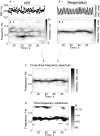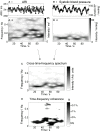Oscillatory behavior of ventricular action potential duration in heart failure patients at respiratory rate and low frequency
- PMID: 25389408
- PMCID: PMC4211392
- DOI: 10.3389/fphys.2014.00414
Oscillatory behavior of ventricular action potential duration in heart failure patients at respiratory rate and low frequency
Abstract
Oscillations of arterial pressure occur spontaneously at a frequency of approximately 0.1 Hz coupled with synchronous oscillations of sympathetic nerve activity ("Mayer waves"). This study investigated the extent to which corresponding oscillations may occur in ventricular action potential duration (APD). Fourteen ambulatory (outpatient) heart failure patients with biventricular pacing devices were studied while seated upright watching movie clips to maintain arousal. Activation recovery intervals (ARI) as a measure of ventricular APD were obtained from unipolar electrograms recorded from the LV epicardial pacing lead during steady state RV pacing from the device. Arterial blood pressure was measured non-invasively (Finapress) and respiration monitored. Oscillations were quantified using time frequency and coherence analysis. Oscillatory behavior of ARI at the respiratory frequency was observed in all subjects. The magnitude of the ARI variation ranged from 2.2 to 6.9 ms (mean 5.0 ms). Coherence analysis showed a correlation with respiratory oscillation for an average of 43% of the recording time at a significance level of p < 0.05. Oscillations in systolic blood pressure in the Mayer wave frequency range were observed in all subjects for whom blood pressure was recorded (n = 13). ARI oscillation in the Mayer wave frequency range was observed in 6/13 subjects (46%) over a range of 2.9 to 9.2 ms. Coherence with Mayer waves at the p < 0.05 significance level was present for an average of 29% of the recording time. In ambulatory patients with heart failure during enhanced mental arousal, left ventricular epicardial APD (ARI) oscillated at the respiratory frequency (approximately 0.25 Hz). In 6 patients (46%) APD oscillated at the slower Mayer wave frequency (approximately 0.1 Hz). These findings may be important in understanding sympathetic activity-related arrhythmogenesis.
Keywords: ARI; Mayer wave; action potential duration; oscillation; respiration.
Figures




References
-
- Anrep G. V., Pascual W., Rossler R. (1936). Respiratory variations of the heart rate. I.-The reflex mechanism of the respiratory arrhythmia. Proc. R. Soc. Lond. B 119B, 191–217. 10.1098/rspb.1936.0005 - DOI
-
- Child N., Hanson B., Bishop M., Rinaldi C. A., Bostock J., Western D., et al. . (2014). Effect of mental challenge induced by movie clips on action potential duration in normal human subjects independent of heart rate. Circ. Arrhythm. Electrophysiol. 15, 2014. 10.1161/CIRCEP.113.000909 - DOI - PMC - PubMed
-
- Coronel R., de Bakker J. M., Wilms-Schopman F. J., Opthof T., Linnenbank A. C., Belterman C. N., et al. . (2006). Monophasic action potentials and activation recovery intervals as measures of ventricular action potential duration: experimental evidence to resolve some controversies. Heart Rhythm 3, 1043–1050. 10.1016/j.hrthm.2006.05.027 - DOI - PubMed
Grants and funding
LinkOut - more resources
Full Text Sources
Other Literature Sources

